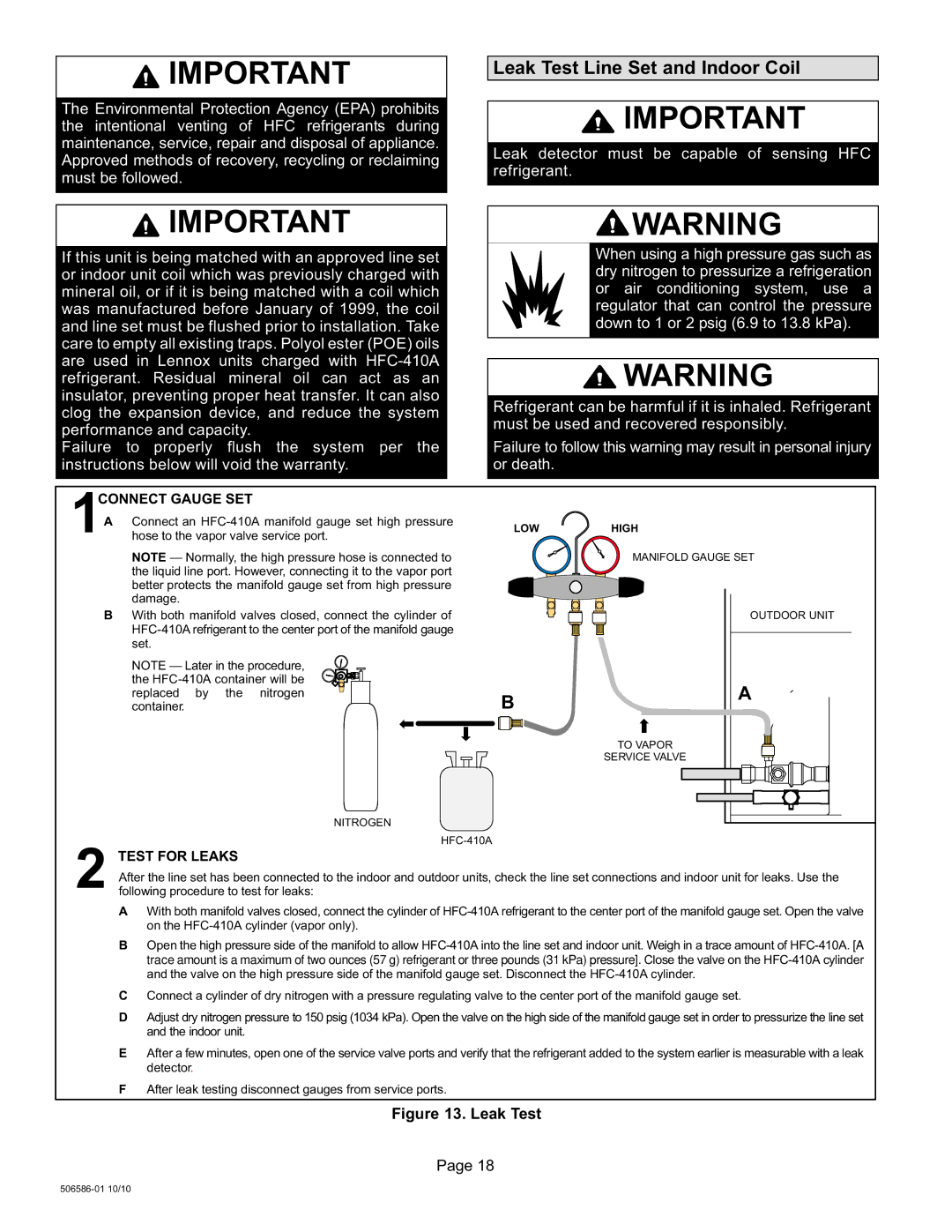
![]() IMPORTANT
IMPORTANT
The Environmental Protection Agency (EPA) prohibits the intentional venting of HFC refrigerants during maintenance, service, repair and disposal of appliance. Approved methods of recovery, recycling or reclaiming must be followed.
Leak Test Line Set and Indoor Coil
![]() IMPORTANT
IMPORTANT
Leak detector must be capable of sensing HFC refrigerant.
![]() IMPORTANT
IMPORTANT
If this unit is being matched with an approved line set or indoor unit coil which was previously charged with mineral oil, or if it is being matched with a coil which was manufactured before January of 1999, the coil and line set must be flushed prior to installation. Take care to empty all existing traps. Polyol ester (POE) oils are used in Lennox units charged with HFC−410A refrigerant. Residual mineral oil can act as an insulator, preventing proper heat transfer. It can also clog the expansion device, and reduce the system performance and capacity.
Failure to properly flush the system per the instructions below will void the warranty.
![]() WARNING
WARNING
When using a high pressure gas such as dry nitrogen to pressurize a refrigeration or air conditioning system, use a regulator that can control the pressure down to 1 or 2 psig (6.9 to 13.8 kPa).
![]() WARNING
WARNING
Refrigerant can be harmful if it is inhaled. Refrigerant must be used and recovered responsibly.
Failure to follow this warning may result in personal injury or death.
1CONNECT GAUGE SET
AConnect an HFC−410A manifold gauge set high pressure hose to the vapor valve service port.
NOTE , the high pressure hose is connected to
the liquid line port. However, connecting it to the vapor port better protects the manifold gauge set from high pressure damage.
BWith both manifold valves closed, connect the cylinder of HFC−410A refrigerant to the center port of the manifold gauge set.
NOTE Later in the procedure, the HFC−410A container will be replaced by the nitrogen container.
LOW
B
HIGH
MANIFOLD GAUGE SET
OUTDOOR UNIT
A
TO VAPOR
SERVICE VALVE
NITROGEN
HFC−410A
2TEST FOR LEAKS
After the line set has been connected to the indoor and outdoor units, check the line set connections and indoor unit for leaks. Use the following procedure to test for leaks:
A With both manifold valves closed, connect the cylinder of HFC−410A refrigerant to the center port of the manifold gauge set. Open the valve on the HFC−410A cylinder (vapor only).
B Open the high pressure side of the manifold to allow HFC−410A into the line set and indoor unit. Weigh in a trace amount of HFC−410A. [A trace amount is a maximum of two ounces (57 g) refrigerant or three pounds (31 kPa) pressure]. Close the valve on the HFC−410A cylinder and the valve on the high pressure side of the manifold gauge set. Disconnect the HFC−410A cylinder.
C Connect a cylinder of dry nitrogen with a pressure regulating valve to the center port of the manifold gauge set.
D Adjust dry nitrogen pressure to 150 psig (1034 kPa). Open the valve on the high side of the manifold gauge set in order to pressurize the line set and the indoor unit.
E After a few minutes, open one of the service valve ports and verify that the refrigerant added to the system earlier is measurable with a leak detector.
F After leak testing disconnect gauges from service ports.
Figure 13. Leak Test
Page 18
506586−01 10/10
